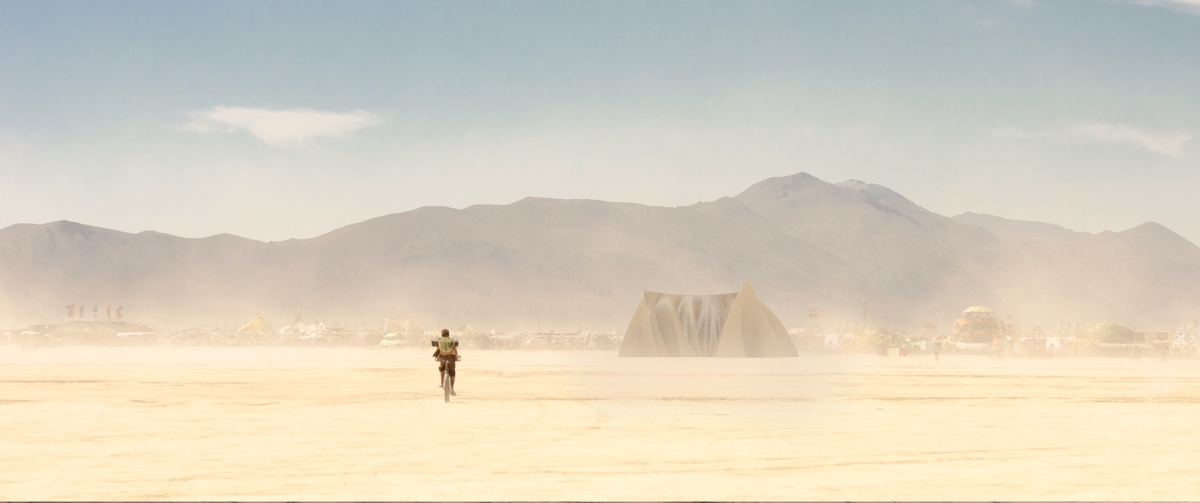Summary
The Wishing Well is the physical manifestation, a snap-shot, of a creature caught in between dimensions – frozen in time. It is a digital entity that has been extracted from its home in the fractured planes of the mathematical realm; a differentially grown curve in bloom, organically filling space in the material world.
The notion of geometry in between dimensions is explored in a previous post: Shapes, Fractals, Time & the Dimensions they Belong to
Description
The piece will be built from the bottom-up. Starting with the profile of a differentially grown curve (a squiggly line), an initial layer will be set in pieces of 2 x 4 inch wooden studs (38 x 89 millimeter profile) laid flat, and anchored to the ground. Each subsequent layer will be built upon and fixed to the last, where each new layer is a slightly smoother version than the last. 210 layers will be used to reach a height of 26 feet (8 meters). The horizontal spaces in between each of the pieces will automatically generate hand and foot holes, making the structure easily climbable. The footprint of the build will be bound to a space 32 x 32 feet.
The design may utilize two layers, inner and out, that meet at the top to increase the structural integrity for the whole build. It will be lit from within, either from the ground with spotlights or with LED strip lights following patterns along the walls.

Ambition
At the Wishing Well, visitors embark on a small journey, exploring the uniquely complex geometry of the structure before them. As they approach the foot of the well, it will stand towering above them, undulating organically across the landscape. The nature of the structure’s curves beckons visitors to explore the piece’s every nook and cranny. Moreover, its stature grants a certain degree of shelter to any traveller seeking refuge from the Playa’s extreme weather conditions. The well’s shape and scale allows natural, and artificial, light to interact in curious ways with the structure throughout the day and night. The horizontal gaps between every ‘brick’ in the wall allows light to filter through each layer, which in turn casts intriguing shadows across the desert. This perforation also allows Burners to easily, and relatively safely, scale the face of the build. Visitors will have the opportunity to grant a wish by writing it down on a tag and fixing it to the well’s interior.

Philosophy
If you had one magical (paradox free) wish, to do anything you like, what would it be?
Anything can be wished for at the Wishing Well, but a wish will not come true if it is deemed too greedy. Visitors must write their wish down on a tag and fix it to the inside of the well. They must choose wisely, as they are only allowed one. Additionally, they may choose to leave a single, precious, offering. However, if the offering does not burn, it will not be accepted. Visitors will also find that they must tread lightly on other people’s wishes and offerings.
The color of the tag and offering are important as they are associated with different meanings:
- ► PINK – love
- ► RED – happiness, joy, success, good luck, passion, vitality, celebration
- ► ORANGE – change, adaptability, spontaneity, concentration
- ► YELLOW – nourishment, warmth, clarity, empathy, being free from worldly cares
- ► GREEN – growth, balance, healing, self-assurance, benevolence, patience
- ► BLUE – conservation, healing, relaxation, exploration, trust, calmness
- ► PURPLE – spiritual awareness, physical and mental healing
- ► BLACK – profoundness, stability, knowledge, trust, adaptability, spontaneity,
- ► WHITE – mourning, righteousness, purity, confidence, intuition, spirits, courage
The Wishing Well is a physical manifestation of the wishes it holds. They are something caught in between – on their way to becoming more. I wish for guests to reflect on where they’ve been, where they are, where they are going, and where they wish to go.







